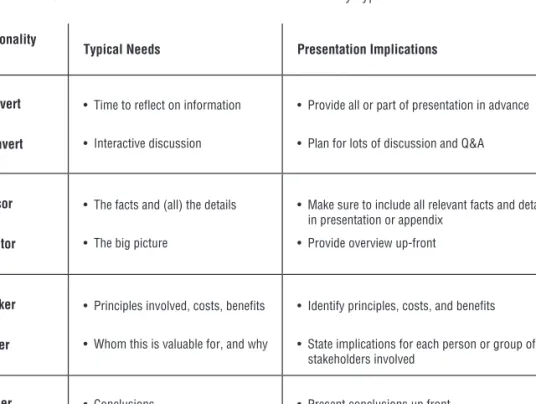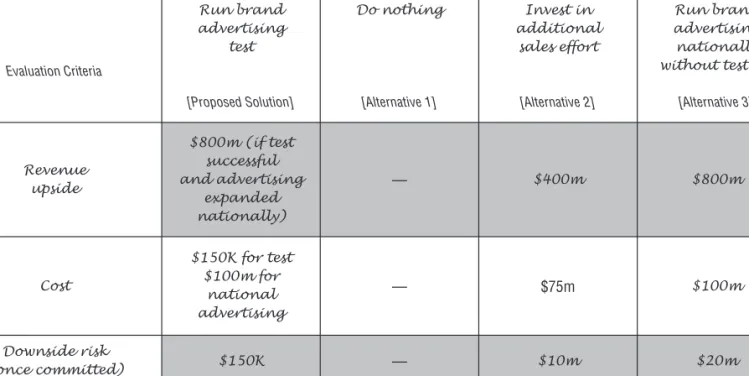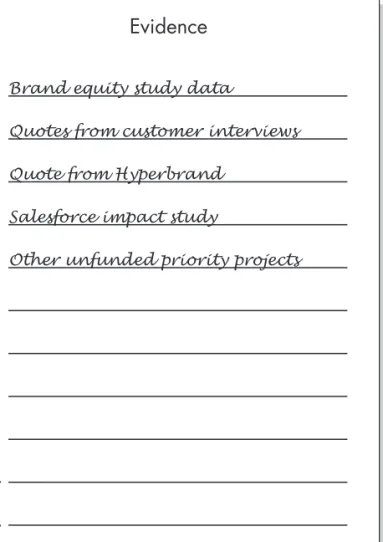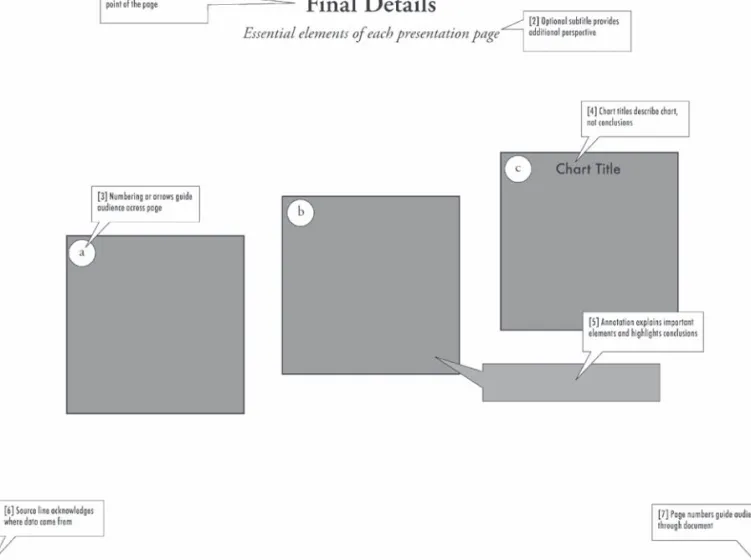This book overturns much of the conventional wisdom and practice of creating presentations to provide a comprehensive yet easy-to-use ten-step method for designing presentations that move your audience to action. The individual chapters then contain material explaining how to implement each of the ten steps in the method.
Contents
POLITICS AND METRICS 15 Politics 15
Identify the Communication Preferences of the Different Personality Types in Your Audience 19
Set Specifi c Objectives for What You Want Your Audience to Think and Do Differently After Your Presentation 29
Identify a Problem Your Audience Has That Your Presentation Will Contribute to Solving 39
List All the Information That You Think You May Need to Include in Your Presentation 57
RHETORIC 63 Logic Alone Is Not Enough 63
Identify Brief Anecdotes That Highlight Your Most Important Points 67
Sequence Your Information So That It Tells a Compelling Story 75 The Structure of All Effective Stories 77
GRAPHICS 89 Should You Use Visual Aids? 90
Identify the Most Effective Graphical Elements to Use in Your Presentation 97
PLACING ALL THE ELEMENTS ON EACH PAGE 107 Step 8: Create slides that convey your information succinctly and effectively 107. Do you want to combine graphics and text on the same slide 133 How to determine exactly what goes on each slide 133.
POLITICS AND METRICS AGAIN 139
Given the importance of this "last mile," I was surprised by how much variation there is in the quality of presentation skills. I am grateful to many people for their help in developing the extreme presentation method and this book.
Why Do We Need to Reinvent the Way We Design Presentations?
THE PURPOSE OF THIS BOOK is nothing less than a complete reinvention of how presentations are designed. The main problem seems to be that presentation tips and tools have been developed for the benefit of the presenter, not the audience5.
How to Reinvent Your Presentation
First, although much of the work in these areas is very insightful, applying it can still be challenging. Creating a presentation that gets your audience to act on your information has become a very difficult challenge - in fact, an extreme challenge due to the overwhelmed, distracted, demanding and skeptical audience - and that's why it needs a extreme solution: Extreme Presentation™ method.
Objectives: Set specific objectives for what you want your audience to think and do differently after your presentation. How to use the from-to/think-do matrix to clearly articulate your presentation objectives about the attitudinal and behavioral changes you want from your audience.
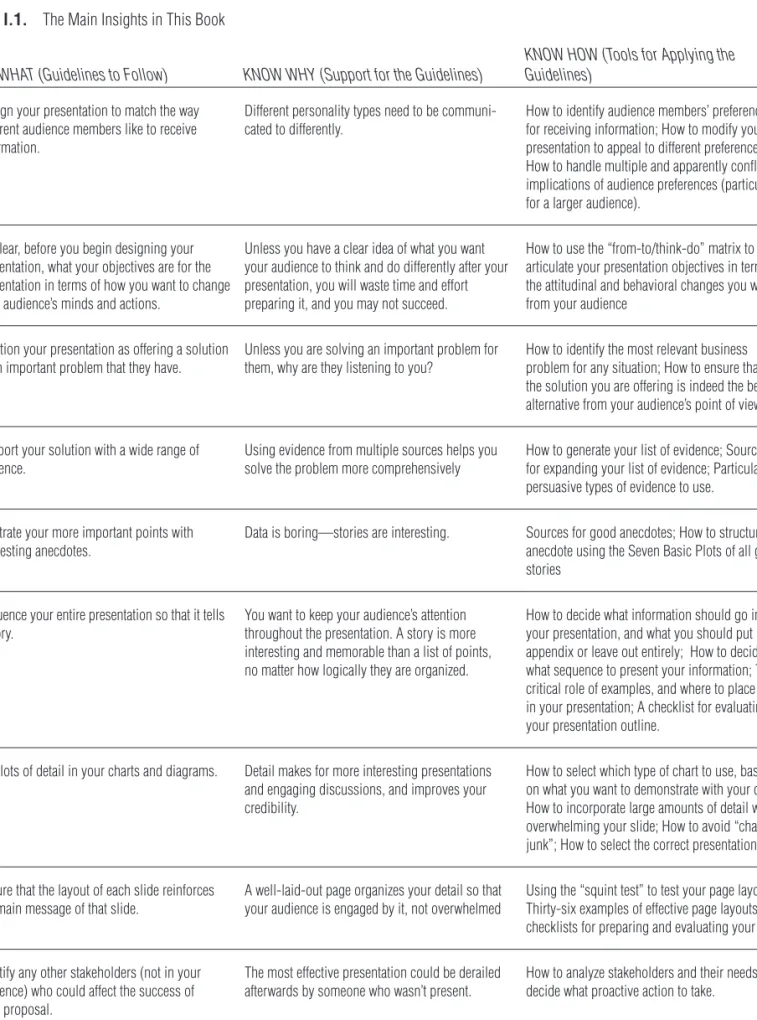
How This Book Is Different from All Other Presentation Books
The remainder of this section describes how this book differs from all other presentation books, what the book is and is not about, and the structure of the book. The methodology presented in this book has been field-tested at some of the largest and most demanding companies in the world.
What This Book Is — and Is Not — About
The reason this book is different is that, as we mentioned above, recent research on many aspects of presentation design contradicts conventional wisdom. The recommendations in this book are supported by the findings of hundreds of empirical studies in the fields of communication, psychology, education, marketing, and law.
The Structure of This Book
And most importantly: how to design a presentation so that my audience acts on my recommendations. First, it's not about the mechanics of using PowerPoint, or any other presentation software.
Politics
Even if you have one of the two most common personality types in leadership (ENTJ or ESTJ in Myers-Briggs terms: i.e. extraverted thinkers, judgment-oriented) and you're presenting to other leaders, chances are you'll still only be appealing to a minority of your audience. However, his categories are also very useful for quickly assessing the personality types likely to be present in your audience, which you can then use to ensure you're communicating in ways that appeal to everyone in your audience.
Metrics
Understanding What
Types of Communication Will Be Most Effective
Identify the Communication Preferences of the Different Personality Types in Your Audience
How to Estimate Your Audience ’ s Personality Types
How to Match Your Presentation Design to Different Personality Types in the Same Audience
To please the intuitives in your audience, you should provide an overview at the beginning of your presentation. If you're an intuitive, you tend to focus on the big picture, and the sensors in your audience may think you're a smooth talker.
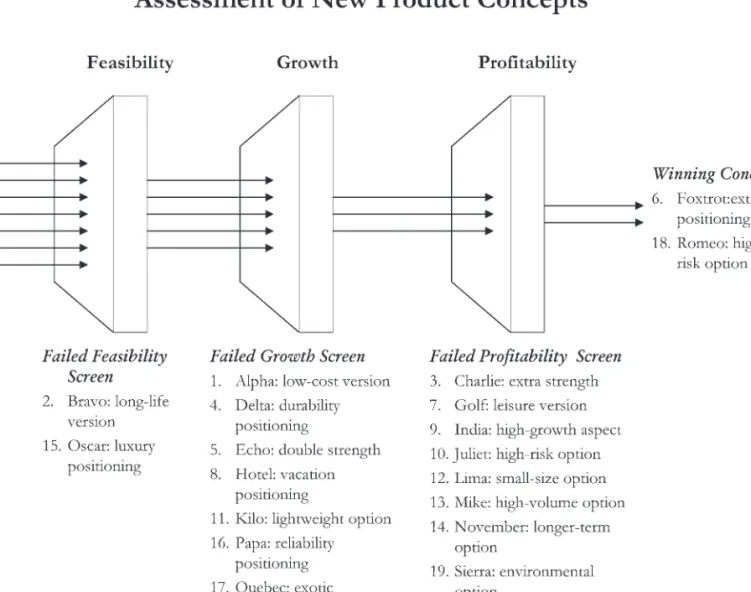
Additional Information About Your Audience
If you can ensure this without going through this exercise, perhaps just by quickly considering who will be in the room and which personality types are most different from your own, it will probably suffice. If you care about communicating effectively with people who don't have the same personality type as you, you do need to go through this first step at some level.
Setting a Measurable 2
Objective for Your Presentation
Set Specifi c Objectives for What You Want Your Audience to Think and Do Differently
After Your Presentation
The Typical — and Wrong — Way to Set Presentation Objectives
Review techniques for front-line service
Communicate the importance of understanding techniques and
Identify areas of improvement in front- line service
OBJECTIVES
How useful is such a set of objectives in terms of knowing whether your presentation has been successful. But what we need is a way of setting goals that is all about the audience, not the presenter.
Developing Effective Presentation Objectives
Think] From thinking that investing in proposed project Thinking] From thinking that current workforce underperformance is due to inadequate resources, to thinking that the lack of required skills is the real problem, and [Doing] from planning to invest in new assistive technology to investing instead in improved staff training.
The Curse of the “ Update ” Presentation
The way to get out of this trap is to force yourself to complete the From – To/Think – Do matrix. The "From - To/Think - To" discipline is also important for training and educational presentations.
How Do You Know Whether You Have Set the Right Objectives?
If you really can't find out, you might want to consider creating two versions of your presentation. Explain why you should always focus your presentation on a serious problem your audience has.
Why You Should Always Focus Your Presentation on an Audience Problem
This includes the business problem your presentation will help your audience solve and the information you will provide to support that solution. Argue against the common belief that style is more important than substance and demonstrate how important the quality of your evidence is to the success of your presentation.
LOGIC
Call or email someone in your audience or someone who knows them and ask. Your presentation must help solve an important problem for your audience if you want to get their attention.
You Do Need Evidence!
Kennedy apparently once said, "The only reason to speak is to change the world." We'll paraphrase this and say that the only reason to present is to solve a problem. If you don't know what problems your audience has and how your presentation could help solve them, find out before you do anything else.
The Reality Principle: Show Concrete and Specifi c Data Whenever Possible
So it's usually more a matter of trying to adapt your presentation to address these realities. The two chapters in this part will show you the "how" to use evidence persuasively in your presentation.
Articulating the 3
Audience ’ s Business Problem and Your
Identify a Problem Your Audience Has That Your Presentation Will Contribute to Solving
If you already understand the importance of focusing your entire presentation on addressing a problem your audience faces, and you know the problem you want to focus on, then write that down, along with a one-sentence summary of the solution. How to find the right problem - Five Whys How to find the right level of analysis.
Why Discuss Problem Solving in a Book About Presentation Design?
If you think you can break this rule, you are better than the best essayists, novelists and playwrights in history. If you're trying to get your audience to act on your recommendations—if you want to "sell" your ideas—then it makes sense to do what successful salespeople do and focus on solving your audience's problem.
Choosing the Right Problem
What if the problem that you have identified is so big that you can do very little to solve it. Not being able to do this thing is then the problem you address for them.
Crafting Your Solution
Very briefly, the surest way to find an effective solution to a problem is to try to find several and then choose the best one. You may also find yourself changing your mind once you understand where they are coming from.

Include Rival Solutions to the One I ’ m Offering?
Marshalling 4
List All the Information That You Think You May Need to Include in Your Presentation
Include all the information you can think of that supports your recommendations, and also evidence against your recommendations - because you're going to have to deal with this information one way or another, so you can't just ignore it. Just list everything you can think of: basically all the information you can think of that is relevant to your solution.
What Kinds of Evidence Should You Include?
Use qualitative and quantitative data, multiple arguments, causal arguments, evidence that is essentially persuasive, evidence for the problem, and evidence against your recommendations. This tends to be true whether or not your audience is very concerned about the issue being discussed.
Is There Any Kind of Evidence That You Should Exclude?
The information that the known “fact” is in fact false is itself a newsworthy piece of information that you can include to make your presentation stand out. More specifically, be careful about including information that will make your audience feel guilty.
Where Do You Find All This Evidence?
It's tempting to think that you can motivate your audience by making them feel guilty if they don't do what you're recommending. If you've worked hard to gather comprehensive, compelling evidence, why not go ahead and use that evidence to convince your audience.
Logic Alone Is Not Enough
The interruption temporarily "disables" the audience's instinctive negative reactions and opens them up to the new information. In contrast, stories are a coherent whole, where one thing flows into the next, so we tend to remember the whole ("The Science of Stories", 1998).
Ethical Persuasion
If instead you're really trying to get them to do what they should do for their own good and the good of the company, then your persuasion is ethical: you're helping them overcome their own inertia so they do the right thing. The techniques presented in this book are very effective in persuading your audience to do what you tell them to do.
Assembling the
Anecdotes That Will
Identify Brief Anecdotes That Highlight Your Most Important Points
What Kinds of Stories Should You Use in Your Presentation?
Again, what makes it real is the specific city - the concreteness - of the details you provide. The people for whom they create the communication are not imbued with either the language of the product or the language of advertising.
How to Tell a Story Using the Seven Basic Plots
You can figure out what type of story plot the anecdote represents, and then make sure you have the right pieces from the column on the right. If you have a really good story that someone else has written, and you don't think you can do it right without reading it word for word, then do it, if it's not too long.
Where to Find Useful Stories
Sequencing 6
Sequence Your Information So That It Tells a Compelling Story
This is the role of plot in this process: it raises a question that creates a need for an answer, which you then provide - a resolution. How exactly to use S.Co.R.E. Situation, Plot, Solution, Example) to sequence your evidence in a way that grabs and holds your audience's attention.
The Structure of All Effective Stories
First Solution Take a green card, write the word "Resolution" at the top left of the card, and then immediately below it write your answer to the problem raised in the first complication: "The solution we propose is. Bad Example 1 Situation: We are here to discuss the shift in ownership of the marketing research budget from the product marketing groups to the market research department.
What to Do with What Doesn ’ t Fit into Your Storyline — The Role of the Appendix
But you cannot know whether the procedures will be adopted if you do not talk to those responsible. If you are using PowerPoint, the ideal slide should have seven bullets with seven words each.
Should You Use Visual Aids?
In a Wired magazine article that popularized this view (entitled “PowerPoint is Evil” and subtitled “Power Corrupts: PowerPoint Corrupts Absolutely”), Tufte (2003a) argued that “PowerPoint's style routinely disrupts, dominates, and trivializes content. From this point of view, Tufte criticizes - correctly - the use of ballroom presentations in situations that require conference room-style presentations.
Should Each Slide Have Seven Bullets and Seven Words Per Bullet?
The “redundancy principle”, that people “learn better from graphics and narration than from graphics and story and redundant text” is well established in research (see especially Mayer, 2001 and Moreno, 2006, p. 65). But written and spoken words use the same short-term memory, so when both are received at the same time, the audience suffers from cognitive overload.
Visual Presentation Elements: Graphics,
Identify the Most Effective Graphical Elements to Use in Your Presentation
What Kinds of Graphics Should You Use?
Your audience has limited processing capacity; irrelevant information can overload this capacity and reduce the effectiveness of your communication.3 On television, clutter reduces the amount of information conveyed; the success of MTV, which included a crowded format, led others, notably CNN, to emulate the mess.
How Do You Decide Which Type of Chart Will Best Communicate Your Data?
To view the distribution of your data, move to the top of Figure 7.1. To the right of that, if you have bivariate data, a scatter plot is suggested, and if you have trivariate data, a 3D area plot.
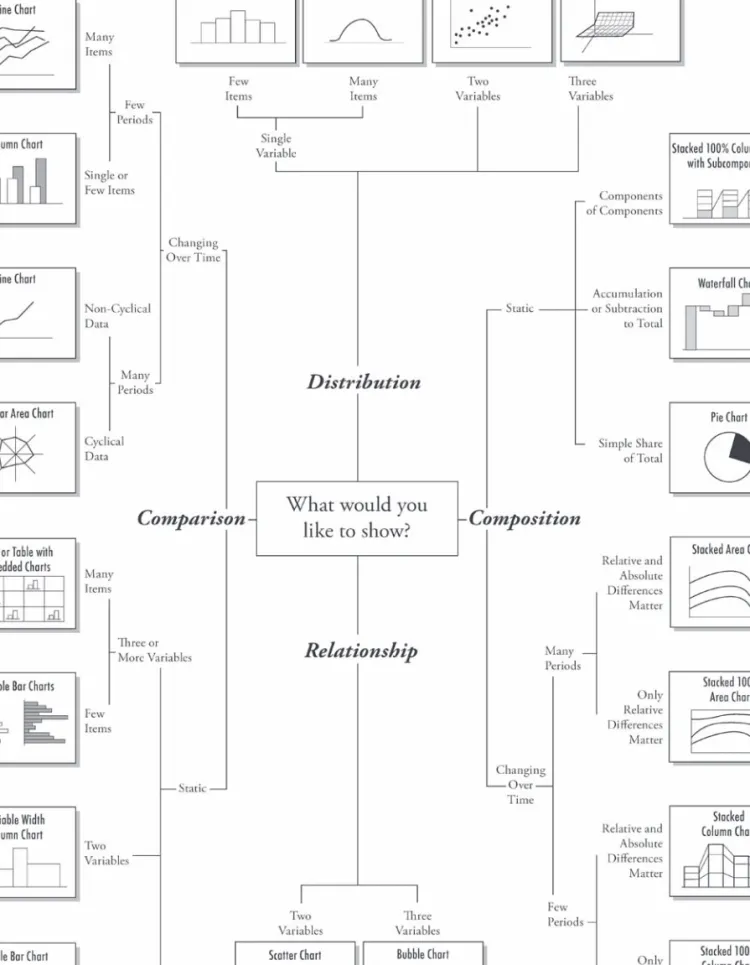
Which Type Fonts and Sizes Should You Use?
As you consider which cards to use, be sure to include plenty of relevant details:. detail improves the persuasiveness of your presentation.
Should You Use Bullet Points, Color, Animation, Transitions, or Animation?
The results of the research on the use of color in communication are mixed as to whether color contributes any benefit. A review of the research on the role of color in speeding the identification of information, from the 1950s to the 1970s, found that irrelevant color impairs both speed and accuracy of information access (Christ, 1975).
Laying Out All the
Create Slides That Communicate Your Information Concisely and Effectively
For example, if the slide is about two alternatives, draw the alternatives on opposite sides of the page (Figure 8.1 a). When explaining how different factors come together to create a new situation, draw the factors on the side of the page and the new situation in the center (Figure 8.1 c).
High Presentation Training Impact
How to make sure your slide layout reinforces the main message of the slide How to design effective ballroom style presentations. How to make sure your slide layout reinforces the main message of the slide.
How to Make Sure That Your Slide Layout Reinforces the Main Message of the Slide
If you can already see what the main message of the page is—for example, that the page shows a process—then your page passes the squint test (see Figure 8.2. If you squint at them, all you see is a bunch of dots, so these slides fail the squint test .
How to Design Effective Ballroom Style Presentations
Because ballroom-style presentations use very little text on each slide, you may end up with many slides, perhaps one (or even more) per minute of presentation. Therefore, the maximum length of a ballroom-style presentation is forty-five slides (forty-five minutes ⫻ one slide/minute).
How to Design Effective Conference Room Style Presentations
But if you project your slides, you decide when to go to the next slide. If you are able to distill your message down to one page, your audience will get the feeling that you have really captured the essence of the topic.
When to Use Multiple Presentation Idioms in the Same Presentation
The theoretical, ideal length of a conference room style presentation is one page – rich in detail and well laid out. What if you get a one-hour time slot for your presentation and you show up with a presentation that is only one page long?
How Much Detail to Put on Each Slide
PLACING ALL ELEMENTS ON EVERY PAGE 117 . ballroom style) lots of details (which only suits the style of a meeting room); and the glass doesn't pass the squint test anyway.
Presentation
And the size of the circle in each box is proportional to the percentage agreement. And at the bottom right of the matrix, X150 and R2000 are products with lower prices and high market share.
How to Avoid Bad Detail ( “ Chartjunk ” )
Much of the criticism centered on the apparent incomprehensibility of the slide: it is “as clear as mud. In fact, I don't think the unintelligibility of the slide is its main problem.
How Much Text to Put on Each Slide
What this essentially is is a presentation on the stages of the HR (human resources) process in a typical company: hiring, developing, deploying and rewarding. They are then deployed in the various functions of the company, bottom right, and through a number of further steps they are rewarded and promoted in the bottom left. You can see some of them climbing the stairs to their next position.
Whether to Combine Graphics and Text on the Same Slide
How Exactly to Decide What Goes on Each Slide
First, you can number the elements on the page in the order you want your audience to view them. Reinforces all the elements on the page the page's main message, as expressed in the page title.

POLITICS AND METRICS AGAIN
Satisfying Your 9
Stakeholders and Measuring Success
Identify Any Potential Roadblocks to Achieving Your Objectives, and Make a Plan to Deal with Each
Decide How You Will Measure the Success of Your Presentation
Attitudes: ask them to what extent they agree/disagree with one or two statements that describe the "thinking" you hope to achieve with your presentation. Once you have decided how you will measure your success, you have completed step ten.
The Scalability of the Extreme Presentation Method
As a result of this exercise, you have created a presentation that will get people to respond to your recommendations. With practice you will get through the ten steps much faster; In all cases, the amount of effort you put into designing your presentation should be directly proportional to the importance of the presentation.
A Language and a Framework for Providing Effective Feedback
This slide is too busy', or 'That slide isn't working for me' or 'Can you make it a little more fun', you and your colleagues can now make more specific comments, such as 'This slide doesn't meet the requirements'. squint test” or “Which complication in your story is the cause of this point.
Contradicting Other Approaches to Presentation Design
Now that you understand the extreme presentation method, you no longer need such help - your pressures can drop their crutches and stand on their own. Instead of trying to tweak your presentation to make it better, we've attacked the root causes of presentation weakness.
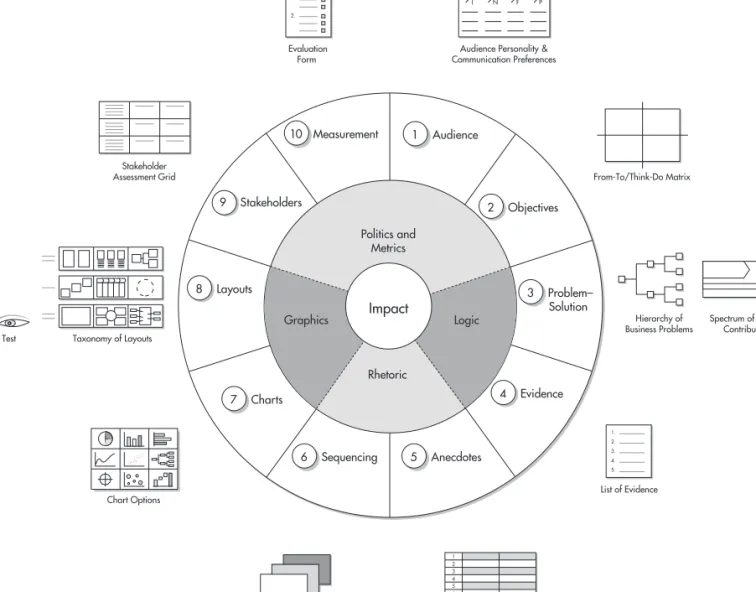
Worksheet A.1b. Audience Personality Implications
Worksheet A.3. Audience Problem The problem that my audience has is
Worksheet A.4. Spectrum of Solution Contributions
Extreme Presentation B
As you can see in Figure B.2, the audience's Myers-Briggs types cover the full range of dimensions, and therefore all presentation implications are checked in Figure B.3. The accompanying spoken part of the presentation could look something like this (you can follow it in Figure B.10.

Thirty - Six Layouts That Pass the Squint Test
A controlled study of the effect of emotionally charged material on declarative memory in Alzheimer's disease. Cognitive processing of persuasive message cues: A meta-analytic review of the effects of supporting information on attitudes.
